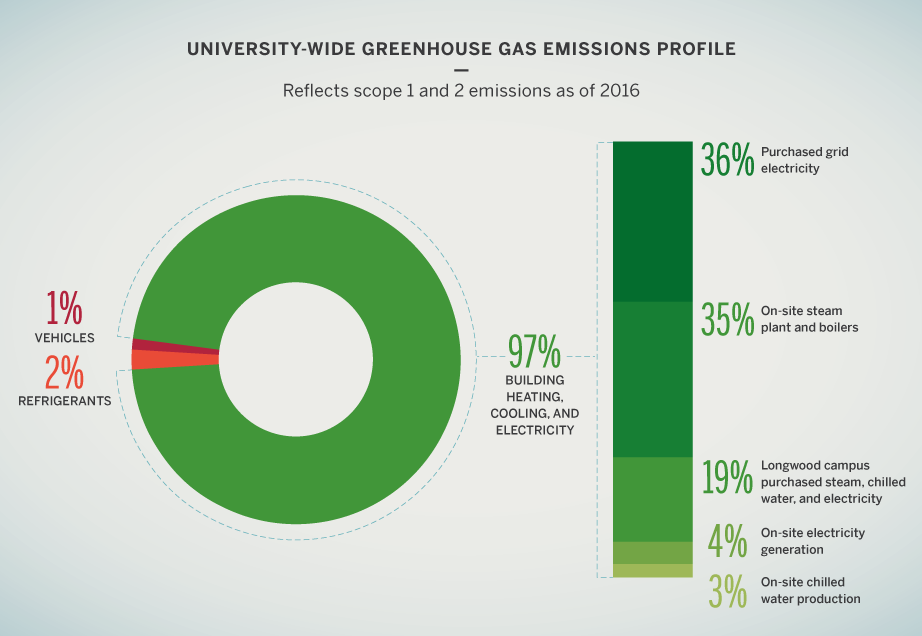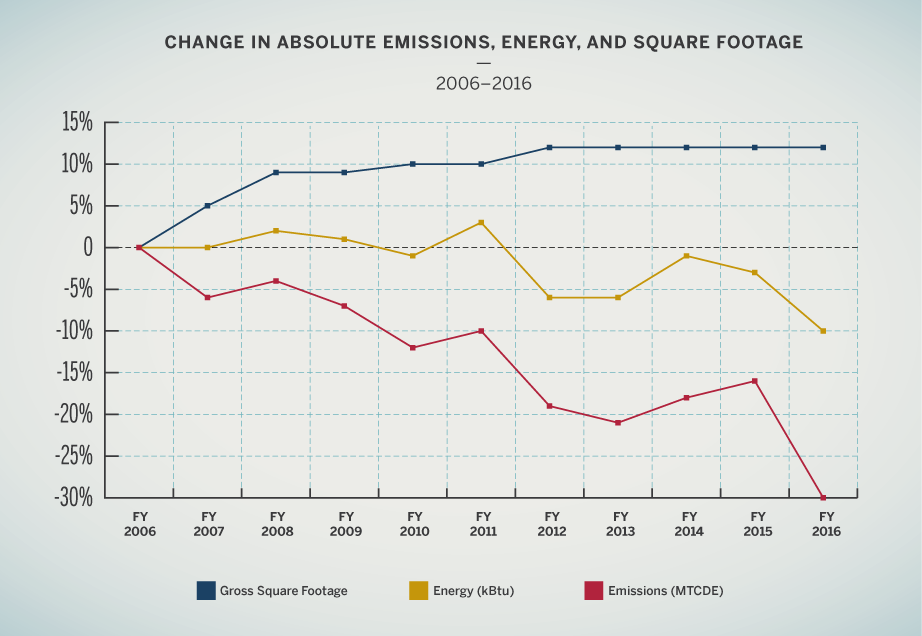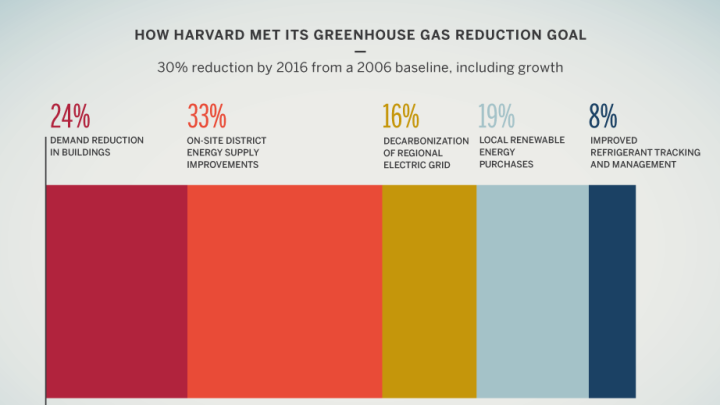Harvard reduced its greenhouse gas (GHG) emissions by 30 percent during the past decade, the Office for Sustainability announced today. The University’s reduction goal, adopted in 2008 and measured from a 2006 baseline, was met despite 15 percent growth in square footage (the addition of 3 million square feet) and an increase in the energy intensity of existing space. (Laboratories, which use 46 percent of the energy on campus but represent just 22 percent of the space, account for a significant portion of this intensification.) The University achieved its goal by reducing demand through widespread implementation of energy-efficiency measures (net energy use measured 10 percent less in 2016 than in 2006); by shifting to renewable energy sources; and by “decarbonizing”—shifting to low-priced natural gas, a less carbon-intensive fossil fuel than oil or coal (whether used to generate electricity or burned directly for heating and cooling).
Controlling Demand
Ninety-seven percent of the University’s emissions are attributable to energy use in buildings (see chart), says Heather Henriksen, who directs the University’s Office for Sustainability (OFS). Thus, nearly a quarter of the reduction in GHG emissions came from reduced demand. Notably, the introduction of more efficient lighting, heating, and cooling of buildings allowed the campus to expand without increasing energy use overall. The reduction, Henriksen notes, followed a period when the University had already pursued a variety of energy conservation measures spurred, for instance, by former president Lawrence H. Summers’s establishment of a “green revolving fund” for efficiency-enhancing projects with paybacks within three to five years. The 30 percent goal itself was not set based on what was deemed possible for Harvard to achieve, but rather on standards the best science said were necessary to help prevent a greater than two-degree rise in global average temperature.
Climate and weather have already begun to affect the University’s overall energy-usage patterns in dramatic ways. In fiscal year (FY) 2015, for example, after an unusual winter with more than 78 inches of snow, energy demand was reported to be just 2 percent below the baseline established in 2006. In FY 2016, however, energy demand dropped to 10 percent below the 2006 level, predominantly due to unexpectedly mild winter weather that required much less heating, says OFS spokesman Colin Durrant. Other factors also played a role: during those fiscal years, Harvard closed its primate research facility in Southborough permanently and brought online a new combined-heat-and-power system at the University-run Blackstone power plant in Cambridge, which allows the plant to generate some of its own electricity. Looking ahead, however, Durrant says that summer temperatures—already trending warmer—are expected to lead to increased cooling demand.

Courtesy of Judy Blomquist/Harvard University
Greening the Supply
Beyond reductions in emissions attributed to lower energy use, the most significant source of reductions resulted from switching fuels, from oil and coal to natural gas, which fell in price during the decade as new domestic supplies became available. This was true both for the regional supply grid from which Harvard buys electricity (16 percent of the emissions reduction reflects these suppliers’ less-carbon-intensive fuels) and for Harvard’s own district energy supply (representing 33 percent of the emissions reduction, the largest portion of which is attributable to the switch to natural gas). A major factor was converting the Blackstone steam plant to natural gas. Other upgrades at that facility and elsewhere, including a larger, combined heat-and-power system, energy-efficient boilers, and improvements to the efficiency of campus chilled-water plants further reduced the emissions impact of Harvard’s energy use. Another 8 percent of the emissions reduction was attributable to improved tracking and management of potent, short-lived pollutants called refrigerants.
All told, Harvard achieved a 24-percent absolute reduction in emissions. To meet the 30 percent goal, Harvard also purchased electricity from offsite renewable energy sources, including wind power from Maine and shares of hydroelectric power from existing generators in Massachusetts. Those purchases represent another 19 percent of the total emissions reduction.
Even with cheap natural gas as a powerful tailwind, attaining Harvard’s initial GHG-reduction goal is notable, given the University’s simultaneous growth in physical plant and energy intensification. Henriksen says successfully meeting the goal required “an unprecedented level of agreement, coordination, and alignment with a vision and a roadmap”—something quite unusual within Harvard’s traditionally decentralized governance structure, a structure she says is more analogous to a multinational company or a government than to most other institutions of higher education. The University’s goal was not to make Harvard the greenest campus in the world, she continues. “We’re doing this to engage faculty and students to translate research into practice. And we are doing this to model how other organizations can [reduce emissions], because that is how we can have impact at scale. That’s the purpose.”
Talking to peers at companies like Google and other universities such as Yale or MIT, which are also committed to mitigating climate change, Henriksen finds that describing her office’s work as an “organizational change effort” resonates. She cites strong leadership from President Drew Faust and the deans, a clear roadmap, clear goals and standards, and ownership in the schools as key ingredients in meeting the 2016 goal, as well as a commitment and governance structure that encourages competition and constant improvement. More than reaching the 30 percent goal, “I think that is what really sets Harvard apart.”
At the outset in 2008, her office created an energy management council that convened every school’s senior facilities and operations manager, as well as administrators and experts in information technology. The group has worked to improve implementation constantly back at the schools (which compete with each other), and to update the University’s own standards. Under executive vice president Katie Lapp, Harvard began incorporating greenhouse-gas accounting into its capital plans. “Every capital plan that is submitted now, every project, has to account for what it does to greenhouse-gas emissions,” says Henriksen.

Courtesy of Judy Blomquist/Harvard University
Looking Ahead
The longer-term trajectory President Faust articulated in 2008—cutting emissions 80 percent by 2050—will likely prove a far greater challenge. A task force has been convened to recommend short and long-term goals beyond 2016, and Henriksen says that in order to achieve deeper cuts in emissions, Harvard will have to look beyond the campus, in part by sufficiently scaling up its renewable power supplies. That in a context where some power demand is rising: as reported earlier, renovations to the undergraduate Houses are leading to higher operational costs, because their systems have been brought up to modern codes, common spaces are air-conditioned, and previously unused basement storage areas have been repurposed into classrooms and studios (see “The Endowment Ebbs,” November-December 2016, page 18). Meanwhile, a new district energy facility in Allston slated to serve the new science building there is said to rely on fossil fuels, eschewing an immediate role for geothermal power. Attaining the 2050 goal will require not only significant reductions in energy consumption as the campus grows further, but also a substantially larger role for renewable supplies in place of fossil fuels.









